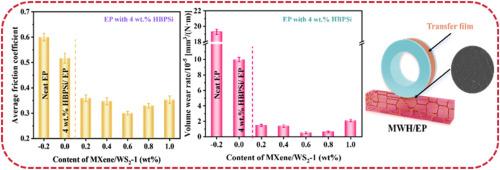HBPSi与MXene/WS2异质结构填料协同增强环氧复合材料的自润滑和耐磨性
IF 9.8
1区 材料科学
Q1 MATERIALS SCIENCE, COMPOSITES
引用次数: 0
摘要
尽管层状MXene和WS2作为环氧树脂(EP)的润滑剂添加剂具有明显的潜力,但由于与EP基体的界面附着力不足,它们的实际应用受到了很大的阻碍。本文合成了带有羟基末端基团的超支化聚硅氧烷(HBPSi-OH),作为“桥接”剂改善异质结构MXene/WS2填料与EP树脂之间的界面粘附。然后,将HBPSi和MXene/WS2杂化体作为增韧剂和润滑剂添加剂加入EP中制备复合材料。MXene/WS2/HBPSi/EP (MWH/EP)复合材料具有优异的力学和摩擦学性能,得益于HBPSi增强的界面结合强度、显著的增韧效果以及HBPSi与MXene/WS2的“软刚性”协同作用。值得注意的是,与原始EP相比,0.6 wt% MXene/WS2-1/4 wt% HBPSi/EP复合材料的冲击强度和弯曲强度分别显著提高了74.6%和48.3%。平均摩擦系数达到最低值0.30,同时体积磨损率降低97%以上。该研究为高性能聚合物复合材料固体润滑剂添加剂的发展做出了重要贡献。本文章由计算机程序翻译,如有差异,请以英文原文为准。

Enhanced self-lubricating and wear-resistance of epoxy composites synergistically reinforced by HBPSi and MXene/WS2 heterostructured filler
Despite the evident potential of layered MXene and WS2 as lubricant additives for epoxy (EP) resin, their practical applications are significantly hindered by inadequate interfacial adhesion with the EP matrix. Herein, hyperbranched polysiloxane with hydroxyl terminal groups (HBPSi–OH) was synthesized, which serves as a “bridge” agent to improve the interfacial adhesion between heterostructured MXene/WS2 filler and EP resin. Then, HBPSi and MXene/WS2 hybrids were incorporated into EP as toughening agents and lubricant additives to fabricate composites. Benefiting from enhanced interfacial bonding strength, prominent toughening effect of HBPSi, “soft-rigid” synergy of HBPSi and MXene/WS2, the MXene/WS2/HBPSi/EP (MWH/EP) composites exhibited remarkable mechanical and tribological properties. Notably, compared with pristine EP, 0.6 wt% MXene/WS2-1/4 wt% HBPSi/EP composite demonstrated significant increases of 74.6 % and 48.3 % in impact and flexural strengths. The average coefficient of friction reaches the lowest value of 0.30, concomitant with a reduction in the volumetric wear rate exceeding 97 %. This study offers significant contributions to the advancement of high-performance solid lubricant additives for polymeric composites.
求助全文
通过发布文献求助,成功后即可免费获取论文全文。
去求助
来源期刊

Composites Science and Technology
工程技术-材料科学:复合
CiteScore
16.20
自引率
9.90%
发文量
611
审稿时长
33 days
期刊介绍:
Composites Science and Technology publishes refereed original articles on the fundamental and applied science of engineering composites. The focus of this journal is on polymeric matrix composites with reinforcements/fillers ranging from nano- to macro-scale. CSTE encourages manuscripts reporting unique, innovative contributions to the physics, chemistry, materials science and applied mechanics aspects of advanced composites.
Besides traditional fiber reinforced composites, novel composites with significant potential for engineering applications are encouraged.
 求助内容:
求助内容: 应助结果提醒方式:
应助结果提醒方式:


